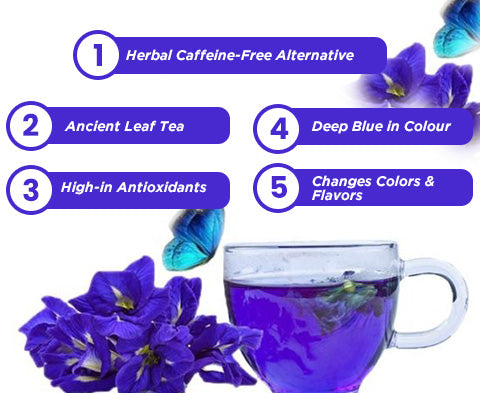Is it safe to drink butterfly pea flower everyday?
Butterfly pea powder, a vibrant blue botanical wonder, has been captivating the attention of health enthusiasts and culinary adventurers alike. As its popularity soars, many are curious about incorporating this azure beauty into their daily routines. But the question remains: Is it safe to drink butterfly pea flower everyday? Let's dive into the world of this fascinating plant and uncover the truth about its daily consumption.
The Surprising Benefits of Butterfly Pea Flower
Butterfly pea flower, scientifically known as Clitoria ternatea, is a striking blue-hued plant that offers a wide range of potential health benefits. Rich in antioxidants, especially anthocyanins, which give the flower its vibrant color, this plant has gained attention for its impressive therapeutic properties. These potent compounds are believed to contribute to several health advantages, including enhanced cognitive function, improved eye health, and possible anti-inflammatory effects.
One of the most compelling areas of research surrounding butterfly pea flower is its potential to support cardiovascular health. Studies suggest that its antioxidants may help regulate blood pressure and cholesterol levels, promoting overall heart health. The flower's rich antioxidant profile could also benefit skin health by combating the oxidative damage caused by free radicals, which may help prevent premature aging and improve skin elasticity.
Additionally, butterfly pea powder is gaining recognition for its adaptogenic qualities, which may help the body adapt to stress. Research indicates that the flower’s active compounds might influence cortisol levels, the body’s primary stress hormone, potentially offering a natural solution for stress relief. By helping to reduce cortisol levels, butterfly pea flower may promote a sense of calm, reduce anxiety, and support overall emotional well-being.

Incorporating butterfly pea flower into one’s diet, whether in tea, powder, or extract form, could provide these health benefits, contributing to a holistic approach to wellness. However, while the flower shows promise in various studies, more research is needed to fully understand its long-term effects. As with any supplement or natural remedy, it’s always wise to consult a healthcare provider before incorporating butterfly pea flower into your health routine.
Potential Risks and Considerations
While butterfly pea flower is generally considered safe for most people when consumed in moderate amounts, it's crucial to be aware of potential risks and considerations before making it a daily habit. Individuals with allergies to legumes should exercise caution, as butterfly pea flower belongs to the Fabaceae family. If you have known allergies to peas, beans, or other legumes, it's advisable to consult with a healthcare professional before incorporating butterfly pea flower into your diet.
Pregnant and breastfeeding women should also approach daily consumption with caution. While traditional use in some cultures suggests safety, there's limited scientific research on the effects of butterfly pea powder during pregnancy and lactation. It's always best to err on the side of caution and seek medical advice in these cases. Those taking blood-thinning medications or preparing for surgery should be mindful of butterfly pea flower's potential mild anticoagulant effects. It's recommended to discontinue use at least two weeks before any scheduled surgical procedures and to consult with a healthcare provider if you're on blood-thinning medication.

Incorporating Butterfly Pea Flower Safely into Your Daily Routine
If you're thinking of adding butterfly pea flower to your daily routine, there are various ways to do so safely and enjoyably. The key is to practice moderation and mindful consumption, ensuring you reap its benefits while avoiding overuse. Start with small amounts and gradually increase as you monitor your body's response. Start with small amounts and gradually increase your intake to assess your body's response. A typical serving of blue matcha powder is about 1-2 grams of dried flowers steeped in hot water. This can be enjoyed once or twice daily.
For those preferring a more convenient option, butterfly pea powder offers versatility in its applications. It can be added to smoothies, baked goods, or used as a natural food coloring. When using the powder form, start with a small amount, such as 1/4 to 1/2 teaspoon per day, and adjust according to your preferences and tolerance.

To maximize the potential benefits while ensuring safety, consider cycling your consumption. This means incorporating butterfly pea flower into your routine for a few weeks, followed by a break. This approach allows your body to reap the benefits while minimizing any potential long-term effects that daily consumption might have. It's also worth noting that the quality of the butterfly pea flower product you choose can impact both its safety and efficacy. Opt for organic, high-quality sources to avoid potential contaminants and ensure you're getting the full spectrum of beneficial compounds.
Conclusion
In conclusion, while butterfly pea flower powder offers a myriad of potential health benefits, the safety of daily consumption depends on individual factors and responsible use. As with any dietary supplement, it's crucial to listen to your body and consult with a healthcare professional, especially if you have pre-existing health conditions or are taking medications.
If you're intrigued by the potential of butterfly pea flower and other natural plant extracts, we invite you to explore further. At Yangge Biotech Co., Ltd., we specialize in providing high-quality, innovative natural ingredients for the food, beverage, and health industries. For more information or to discuss how our products can enhance your offerings, please don't hesitate to reach out to us at info@yanggebiotech.com.
References
1. Mukherjee, P. K., et al. (2008). The Ayurvedic medicine Clitoria ternatea—From traditional use to scientific assessment. Journal of Ethnopharmacology, 120(3), 291-301.
2. Siti Azima, A. M., et al. (2017). Phenolic composition and antioxidant activity of Clitoria ternatea flower petals. Journal of Food Science, 82(5), 1257-1264.
3. Chusak, C., et al. (2018). Acute effect of Clitoria ternatea flower beverage on glycemic response and antioxidant capacity in healthy subjects: a randomized crossover trial. BMC Complementary and Alternative Medicine, 18(1), 6.
4. Akter, R., et al. (2014). Evaluation of analgesic and antioxidant potential of the leaves of Clitoria ternatea Linn. BMC Complementary and Alternative Medicine, 14(1), 398.
5. Suresh, V., et al. (2012). Evaluation of anti-inflammatory effect of aqueous extract of Clitoria ternatea Linn. flower in experimental models. International Journal of Drug Development and Research, 4(1), 144-150.
Send Inquiry
Related Industry Knowledge
- what is the difference between blue spirulina and pea powder?
- what is the best blue spirulina powder?
- Exploring Resveratrol: Nature’s Superfood Antioxidant
- NMN Powder: A Must-Have for Your Wellness Routine
- How long does it take for 5-HTP to start working?
- Bovine Collagen Peptides: Benefits, Uses You Should Know
- Natural Garlic Tablets: Benefits and Uses
- L-Isoleucine: The Essential Amino Acid for Muscle Health, Energy, and Recovery
- is sunflower lecithin healthy?
- What are the health benefits of red radish powder?


